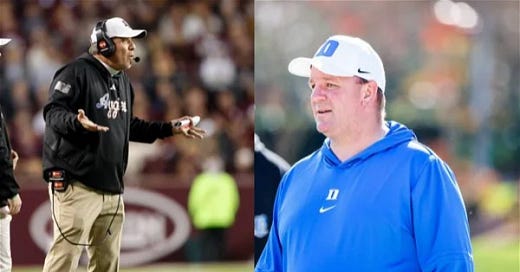As of midnight December 4th, the transfer portal opened for college football. Athletes in college football will have 30 days after the end of the season closing on January 2, 2024. It will reopen 15 days in the spring for a total of 45-day window (a reduction from 60 days in the past). For athletes playing in the College Football Playoff, they will have an additional five days in January. Accordingly, there will be the annual chorus of criticism of athletes and, despite many coaching moves, these coaching changes will be applauded and handsomely rewarded.
Exposé famously sang, ‘Seasons change. Feelings change’ in the 1980s. Similarly, it is the time of season for coaches and athletes to make a change. Coaches face few (if any) NCAA restrictions in finding greener pastures. On the other hand, athletes are constantly regulated on the types of moves they can make. In typical fashion, the NCAA limited the number of days the transfer portal will be open. It was praised by universities, coaches, and athletic department personnel alike.
In a short amount of time, there have already been many high profile coaching moves. Dealing with disgraced Michigan State coaching situation, Jonathan Smith took his success at Oregon State and parlayed it into a high profile Big Ten job. Texas A&M’s former coach Jimbo Fisher—with his massive contract (and buy-out)—was replaced with former Texas A&M coordinator and Duke head coach Mike Elko. Jame Madison’s old coach, Curt Cignetti, led his school from FBC dominance to immediate FBS success jumped to coach Big Ten Indiana.
As every year, many of these moves are vociferously celebrated. The discussions center on failures of past hires (buy-outs), potential success of new coach and staff, what they will bring to the program (recruits, transfers, donor interest), and, of course, the attractive salaries these new coaches will receive.
CBS Sports tracks the Coaching Carousel in college football. It is only early December and there have already been 10 major moves and 8 vacancies. Additionally, there have been 7 extensions or retention efforts for fear of losing those coaches. This only covers head coaches and not the many dozens of assistant coaches and staff members who will change programs.
This is just the beginning of the inevitable trend of the many moves and transfers in the coaching world endorsed by universities and the NCAA. It will be described as natural flow in a free market system. Adults taking their skills and services elsewhere to a higher bidder. Other than annoyed fans, rarely will you see any serious commentary or rule changes on the crisis of the ‘coaching transfer portal’ and how it affects players, recruits, and program stability.
Instead, the scrutiny will be on the athletes. Indeed, from August 2022 to 2023 over 2,400 FBS scholarship players entered their names in the NCAA transfer portal with a trend of expected increase. Like in the past, it will be highly criticized and frowned upon.
The arguments will be that athletes don’t understand loyalty. They don’t know how to ‘suck it up’ when times are tough. They don’t appreciate the privilege it is to be a student-athlete and on scholarship for the sport they love. Freedom of movement is good in our market system, but not for adult-aged athletes who play a sport for a university. They will be criticized for chasing NIL money or criticized for staying only for NIL money because schools (and respective agents) realized the value of an athlete and scrambled to retain that athlete after the fact.
There have already been many high-profile player transfers announced. Many programs and coaches have and will build their programs on the player transfer portal. The popularity of college football has not waned and only appears to be increasing. The controversy on the College Football Playoff (undefeated, ACC champions Florida State left off) and likely high ratings when Alabama plays Michigan and Texas plays Washington. Player movement is not a bad thing or reflection of that generation of athletes or young people. If anything, it mirrors what the older generations are doing or modeling their behaviors. The economic model in college athletics is slowly but surely moving in direction of compensating players.
We can’t continue to cheer moves by college administrators and coaches while levying all the criticism on the athlete for doing the same thing. Many will be tuned in to watch the College Football Playoff. In one of the games, the University of Texas Longhorns will be featuring QB Quinn Ewers (Ohio State transfer) and University of Washington Huskies QB Michael Penix Jr. (Indiana University transfer) among many other transfer on the four teams. Freedom of movement can be positive. Let’s not focus on solely criticizing the athlete. Perhaps they should be celebrated in the same manner as career-jumping coaches and impatient universities.






Good mix of data points and anecdotal references to highlight the flaws in the athlete vs everyone else power dynamic. The passion in the criticism and mischaracterization of athletes is what drove me away from sports for a while. Ironically, relatively little scrutiny is leveed at the fans, schools, coaching staff etc., when they can't "suck it up" to manage through a series of bad showings by their marquee players / team. There is a usually a rallying call to bench them, get rid of them or some other dehumanizing sentiment that is typically used in reference to livestock. What should not come as a surprise is how consistent this story is throughout history when the power shifts into the hands of the less powerful and powerless.